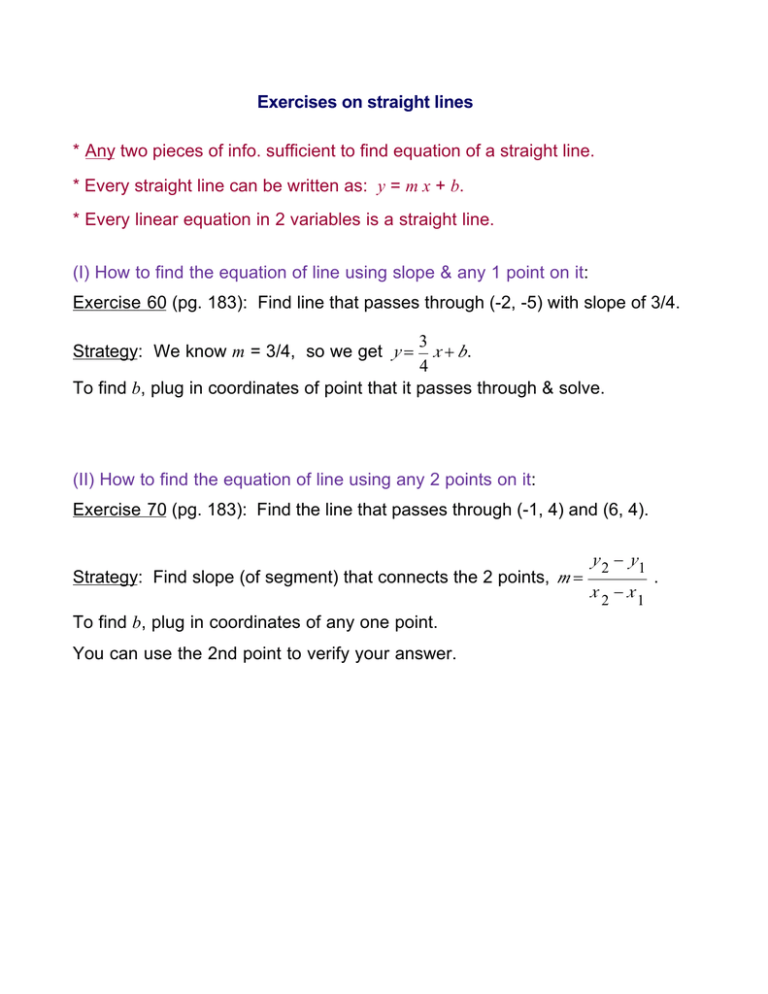Exercises on straight lines * Any two pieces of info. sufficient to find
advertisement

Exercises on straight lines * Any two pieces of info. sufficient to find equation of a straight line. * Every straight line can be written as: y = m x + b. * Every linear equation in 2 variables is a straight line. (I) How to find the equation of line using slope & any 1 point on it: Exercise 60 (pg. 183): Find line that passes through (-2, -5) with slope of 3/4. 3 x + b. 4 To find b, plug in coordinates of point that it passes through & solve. Strategy: We know m = 3/4, so we get y = (II) How to find the equation of line using any 2 points on it: Exercise 70 (pg. 183): Find the line that passes through (-1, 4) and (6, 4). y 2 − y1 Strategy: Find slope (of segment) that connects the 2 points, m = . x 2 − x1 To find b, plug in coordinates of any one point. You can use the 2nd point to verify your answer. (III) How to find the equation of line using its x-intercept & y-intercept: Exercise 84 (pg. 183): Find the line with x-intercept = 2/3, y-intercept = -2. Strategy: Find slope (of segment) that connects the 2 intercepts, m = We are given the y-intercept, so we can directly plug into y = m x + b. y2 −0 0− x1 . Function graphs: Key things to observe f (x) f (x ) = x 3 − 3 x 2 − 4 x + 12 x (1) Zeros: x-values where graph crosses the x-axis. (2) Increasing/Decreasing intervals: Moving left to right, any x-interval where graph is rising ⇒ increasing x-interval where graph is falling ⇒ decreasing (3) Relative extrema (minimum/maximum): any x-value where graph reaches a peak ⇒ maximum x-value where graph reaches valley ⇒ minimum A function always switches direction (e.g., incr. to decr.) at such points. (4) Even & odd functions: graph is symmetric with respect to y-axis ⇒ even [ f (x) = f (-x) ] symmetric with respect to origin ⇒ odd Q: What is symmetry with respect to x-axis called? [ f (x) = -f (-x) ] Some function "Role Models" Objective: To learn to recognize the graph & algebraic form of a handful of special functions that shall serve as "role models" for all future functions! We consider the following specific functions: (1) f (x) = 1 [ = x0 ] (2) f (x) = x [ = x1 ] (3) f (x) = x 2 (4) f (x) = x 3 (5) f (x) = (6) (7) x 1 x f (x) = x f (x) = [ = x 1/2 ] [ = x -1 ] For each case, try to remember the following specific attributes: * Graph shape * Domain & range (e.g., is it always positive, always negative, or both) * Where is the graph increasing & where is it decreasing. * What kind of symmetry, if any. (1) f (x) = 1: Constant case: * Graph is Horizontal straight line. y=1 for all values of x. * Domain is all reals. Range is y=1. * Symmetry about y-axis (i.e., even function). (2) f (x) = x: Linear case: * Graph is straight line with positive slope=1. * Domain & range include all reals. * Increases on (-∞, ∞) * Symmetry about origin (i.e., odd function) (3) f (x) = x2: Quadratic case: * Graph is parabola - opens up - nose at origin. * Domain: all reals; Range: only positive reals. * Decreases (-∞,0); increases (0, ∞) * Symmetry about y-axis (i.e., even function). (4) f (x) = x3: Cubic case: * Graph shape is like a “stretched out” N. * Domain & Range: all reals. * Increases on (-∞, ∞) * Symmetry about origin (i.e., odd function). (5) f (x) = √ x: Square root case: * Graph looks like a slowly ascending airplane! Starts from origin. * Domain & Range: only positive reals. * Increases on (0, ∞) * Symmetry: None. (6) f (x) = 1/ x: Reciprocal case: * Graph like “bowls” in 1st and 3rd quadrants. * Domain & Range: all reals except 0. * Decreases: (-∞, 0), decreases: (0, ∞) * Symmetry: about origin (odd function) (7) f (x) = |x|: Absolute value case: * Graph like a V-shape - base at origin. * Domain: all reals. Range: only + reals. * Decreases: (-∞, 0) Increases: (0, ∞) * Symmetry: about y-axis (even function) How to move and/or stretch functions Objective: To learn the effect of certain common algebraic operations on the graphs of functions. We look at 3 types of effects on functions: (1) How to move the graph up/down or left/right like a rigid body (2) How to create mirror reflections of graphs (3) How to shrink or stretch the graph horizontally or vertically [View powerpoints from textbook website for good illustration of concept.] Summary of key results Translation (1) If you add (or subtract) a constant c to f (x), you move it up (or down). e.g., x3-2 is just x3 shifted down by 2 units | x - 2 | + 3 is just | x - 2 | shifted up by 3 units (2) If you replace every x by x+c or x-c you shift the graph left or right. e.g., (x-2)3 is just x3 shifted right by 2 units | x + 2 | is just | x | shifted left by 2 units Reflection (1) If you flip the sign of every term in f (x), you get its reflection about x-axis. e.g., x3-2 is just the reflection of -x3+2 about the x-axis - | x + 2 | is just the reflection of | x + 2 | about the x-axis (2) If you replace every x by - x you get the graph's reflection about the y-axis. e.g., x3-2 is just the reflection of -x3-2 about the y-axis | x + 2 | is just the reflection of | - x + 2 | about the y-axis Stretching & shrinking (1) If you multiply f (x) by a constant c it stretches or compresses vertically. e.g., 4 x3 is just the graph of x3 stretched vertically (in y-direction) - | x + 2 | is just the reflection of | x + 2 | about the x-axis (2) If you replace every x by c x it stretches or compresses horizontally. e.g., | 4 x + 2 | is just | x + 2 | compressed horizontally Inverses of functions Objective: To understand what is the inverse of a function & to learn how to find it. Summary of key ideas * An inverse is very much like working with a function backwards -- i.e., if y = f (x), we look for a relationship that takes y as input and gives back x. * Many functions have inverse functions, but not all do. * The inverse relationship works both ways when a function does have an inverse. i.e., if g (x) is the inverse of f (x), then f (x) is the inverse of g (x). * The domain & range get reversed -- if g (x) is the inverse of f (x), then the domain of g is the range of f and vice versa. * Composition result: Since the inverse function essentially "undoes" the effect of the orginal function, when we use them back-to-back x remains unchanged. That is: f (g (x) ) = x and g (f (x) ) = x. * Existence of inverse: An inverse exists for any function only provided it is one-to-one. This means the function must not only be single-valued, but also may not have multiple x-values that give the same y-value. e.g., f(x) = x2 does not have an inverse since x and -x give the same y-value. * Notation: The inverse of any function f (x) is written as f -1(x).

